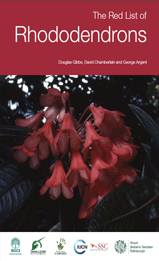|
THE RED LIST OF RHODODENDRONS
Rhododendrons are stunning horticultural plants, beloved of gardeners around the world and cultivated throughout temperate regions. In the wild they are mainly associated with centres of diversity in the Himalayas and in South East Asia, where they form important components of montane ecosystems. In total over 1000 species are recognised and the genus is subject to ongoing taxonomic debate.
The Red List of Rhododendrons was published in 2011 by Botanic Gardens Conservation International (BGCI), the IUCN/SSC Global Tree Specialist Group and the Royal Botanic Garden Edinburgh. The publication arose out of an international workshop to assess the distribution and status of rhododendrons using theIUCN Red List Categories and Criteria, which was held at the Singapore Botanic Garden in July 2008.
The list evaluates 1157 rhododendrons (1018 species, 87 of which
were evaluated at the infraspecific level - 226 subspecies and varieties). Of these, 316 rhododendrons were found to be threatened with extinction in the wild, with one species found to already be extinct in the wild. One species was found to be extinct completely, with no known specimens growing in the wild or in cultivation.
This is of great concern as rhododendrons are beloved by horticulturists around the world for their flowers. But as the report notes, they are also valued for their medicinal properties, and in some communities they are used for firewood, timber, teas, honey, wine, jams, narcotics, etc, and also as sources of insecticides. Rhododendrons also grow in areas of high rainfall and high humidity, on acidic soils; conditions under which few plants would survive. They stabilize slopes and protect watersheds, notably in the Himalayas where so many of Asia’s major rivers start; and they support a wealth of biodiversity too.
Download the full report for free here: Red List of Rhododendrons (PDF, 5MB). Hard copies of the report are also available, please contact us to request one.
Back to Tree Red Listing
|

|







